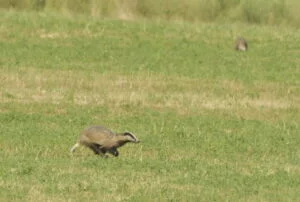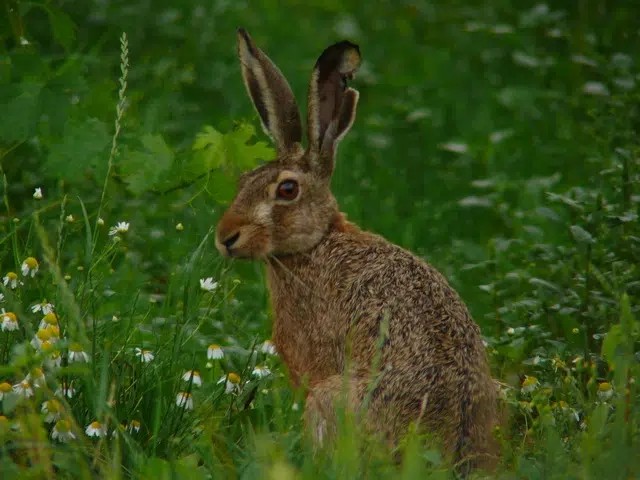European badger – Meles meles
The European badger (Meles meles), also known as the Eurasian badger, is a badger species in the family Mustelidae native to Europe and West Asia and parts of Central Asia. It is classified as least concern on the IUCN Red List, as it has a wide range and a large, stable population size which is thought to be increasing in some regions. Several subspecies are recognized, with the nominate subspecies (M. m. meles) predominating in most of Europe. In Europe, where no other badger species commonly occurs, it is generally just called the “badger“.
The European badger is a powerfully built, black, white, brown, and grey animal with a small head, a stocky body, small black eyes, and a short tail. Its weight varies, being 7–13 kg (15–29 lb) in spring, but building up to 15–17 kg (33–37 lb) in autumn before the winter sleep period. It is nocturnal and is a social, burrowing animal that sleeps during the day in one of several setts in its territorial range. These burrows have multiple chambers and entrances, and are extensive systems of underground passages of 35–81 m (115–266 ft) length. They house several badger families that use these setts for decades. Badgers are fussy over the cleanliness of their burrow, carrying in fresh bedding and removing soiled material, and they defecate in latrines strategically situated outside their setts or en route to other setts.
Although classified as a carnivore, the European badger is an omnivore, feeding on a wide variety of plant and animal foods, including earthworms, large insects, small mammals, carrion, cereals, and tubers. Litters of up to five cubs are produced in spring. The young are weaned a few months later, but usually remain within the family group. The European badger has been known to share its burrow with other species, such as rabbits, red foxes, and raccoon dogs, but it can be ferocious when provoked, a trait which has been exploited in the now-illegal blood sport of badger-baiting. Badgers can be carriers of bovine tuberculosis, which also affects cattle. In England, badger populations are culled to try to reduce the incidence of bovine tuberculosis in cattle, although the efficacy of this practice is strongly disputed, and badger culls are widely considered cruel and inhumane.
Nomenclature
The source of the word “badger” is uncertain. The Oxford English Dictionary states it probably derives from “badge” + -ard, a reference to the white mark on its forehead that resembles a badge, and may date to the early 16th century. The French word bêcheur (‘digger’) has also been suggested as a source. A male badger is a boar, a female is a sow, and a young badger is a cub. A badger’s home is called a sett.Badger colonies are often called clans.
The far older name “brock” (Old English: brocc), (Scots: brock) is a Celtic loanword (cf. Gaelic broc and Welsh broch, from Proto-Celtic *brokko) meaning ‘grey’. The Proto-Germanic term was *þahsu- (cf. German Dachs, Dutch das, Norwegian svin-toks; Early Modern English dasse), probably from the PIE root *tek’- ‘to construct’, which suggests that the badger was named after its digging of setts (tunnels); the Germanic term *þahsu- became taxus or taxō, -ōnis in Latin glosses, replacing mēlēs (‘marten‘ or ‘badger’), and from these words the common Romance terms for the animal evolved (Italian tasso, French tesson/taisson/tasson—now blaireau is more common—, Catalan toixó, Spanish tejón, Portuguese texugo) except Asturian melandru.
Until the mid-18th century, European badgers were variously known in English as brock, pate, grey, and bawson. The name “bawson” is derived from “bawsened”, which refers to something striped with white. “Pate” is a local name that was once popular in northern England. The name “badget” was once common, but only used in Norfolk, while “earth dog” was used in southern Ireland. The badger is commonly referred to in Welsh as a mochyn daear (‘earth pig’).
Common on dry part of the Danube Delta.
photo: Mihai Baciu

